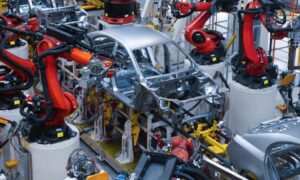This is an introductory lesson on agriculture and farming technology as applied to current issues of production and competitiveness. There are several opportunities for the class to discuss how agricultural technology has increased farming productivity and allowed farmers to operate their businesses with fewer workers. The class can then move on to address issues concerning agricultural markets, food prices, and food safety. Throughout the semester, students will practice market surveys of quality of life in rural America.
A summary of topics covered includes the definition of agriculture, the history of farming technology, different types of farming and what the future might hold for the industry. Agriculture is one of the world’s largest contributors to global food markets. Throughout the U.S., millions of acres of agricultural land are used to grow fruits, vegetables, livestock, and other crops for consumption or exports. Much of this agricultural land is in poor condition and struggling to produce adequate crops. Some farmers have been forced to abandon or sell their lands, at risk of being unable to sustain themselves or their families.
Agriculture relies on various forms of farming technology including irrigation systems, fertilizers, pesticides, and hormones to help farmers achieve higher crop yields, improve land and water management, and protect the crops from insects, disease, and severe weather. In the last 20 years, advancements in farming technology have led to unprecedented changes in the quality of our food, the availability of crops, and the profitability of farmers. Modern day agriculture is able to provide food markets with a greater variety of products while decreasing the amount of land needed to produce those products. In fact, farmers are finding that they can grow crops on less land than ever before.
Agriculture and farming technology advancements have also created new markets for farmers. Biotechnology and genetic engineering have developed amazing advances in breeding techniques, yield better crops, and increasing crop production. New techniques, such as herbicide-resistant superweeds, have made it easier and more effective to control pests and diseases. New breeds of cattle and sheep have increased feed consumption efficiency, improved animal health, and increased consumer confidence in the products of farmers. These innovations have created and increased job opportunities in the agriculture industry, with specialists in various fields contributing to the improvements of crops and livestock.
Advances in farming technology have allowed farmers to increase crop production while reducing costs. Advances in seed saving and consolidation have meant that farmers are able to save money on seed purchases and implement effective policies for the consolidation of debts owed by different kinds of borrowers. Other advances in farming technology allow farmers to process raw materials more efficiently. The creation of high speed, automated vehicles has meant less time spent driving to and from farms. With these new and modern methods of transportation, farmers are able to distribute their products to retail shops and other consumers more quickly and efficiently.
Advancements in modern technology have also allowed farmers to compete successfully with large-scale commercial agricultural producers in the marketplace. With improved breeding techniques and more efficient farming methods, farmers are able to produce high quality, durable livestock and fruits and vegetables at a lower cost. Modern farming technology is improving all aspects of the agricultural industry, allowing farmers to produce more for less and provide consumers with better quality products. As a result, farmers have more profit available to put towards other pressing needs.




































